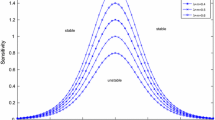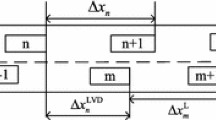Abstract
Existing improved versions of the optimal velocity model have been proved to be capable to enhance the traffic flow stability against a small perturbation with the cooperative control of other vehicles. In this paper, we propose an extended optimal velocity model with consideration of velocity difference between the current velocity and the historical velocity of the considered vehicle. We conduct the linear stability analysis to the extended model with concluding that the traffic flow can be stabilized by taking into account the velocity difference between the current velocity and the historical velocity of the considered vehicle. Namely, the traffic stability can be improved only by each vehicle’s self-stabilizing control, without the cooperative driving control from others. It is also found that the time gap between the current velocity and the historical velocity has an important impact on the stability criterion. To describe the phase transition, the mKdV equation near the critical point is derived by using the reductive perturbation method. The theoretical results are verified using numerical simulation. Finally, it is clarified that the self-stabilizing control in velocity is essentially equivalent to the parameter adjusting of the sensitivity.







Similar content being viewed by others
References
Orosz, G., Wilson, R.E., Krauskopf, B.: Global bifurcation investigation of an optimal velocity traffic model with driver reaction time. Phys. Rev. E 70, 026207 (2004)
Peng, G.H., Nie, Y.F., Cao, B.F., Liu, C.Q.: A driver’s memory lattice model of traffic flow and its numerical simulation. Nonlinear Dyn. 67, 1811–1815 (2012)
Nagatani, T.: The physics of traffic jams. Rep. Prog. Phys. 65, 1331–1386 (2002)
Zhu, W.X., Zhang, C.H.: Analysis of energy dissipation in traffic flow with a variable slope. Phys. A 392, 3301–3307 (2013)
Zhu, W.X.: Motion energy dissipation in traffic flow on a curved road. Int. J. Mod. Phys. C 24, 1350046 (2013)
Ge, H.X., Dai, S.Q., Dong, L.Y.: Xue. Y.: Stabilization effect of traffic flow in an extended car-following model based on an intelligent transportation system application. Phys. Rev. E 70, 066134 (2004)
Bando, M., Hasebe, K., Nakayama, A.: Dynamical model of traffic congestion and numerical simulation. Phys. Rev. E 51, 1035–1042 (1995)
Helbing, D., Tilch, B.: Generalized force model of traffic dynamics. Phys. Rev. E 58, 133–138 (1998)
Jiang, R., Wu, Q., Zhu, Z.: Full velocity difference model for a car-following theory. Phys. Rev. E 64, 017101 (2001)
Li, Z.P., Liu, Y.: A velocity-difference-separation model for car-following theory. Chin. Phys. 15, 1570–1576 (2006)
Nagatani, T.: Stabilization and enhancement of traffic flow by the next-nearest-neighbor interaction. Phys. Rev. E 60, 6395–6401 (1999)
Li, Z.P., Zhang, R.: An extended non-lane-based optimal velocity model with dynamic collaboration. Math. Probl. Eng. 124908 (2013)
Wen, J.A., Tian, H.H., Xue, Y.: Lattice hydrodynamic model for pedestrian traffic with the next-nearest-neighbor pedestrian. Acta Phys. Sinch. E.D 59, 3817–3823 (2010)
Xue, Y.: Lattice models of the optimal traffic current. Acta Phys. SinCh. E.D 53, 25–30 (2004)
Hua, Y.M., Ma, T.S., Chen, J.Z.: An extended multi-anticipative delay model of traffic flow. Commun. Nonlinear Sci. Numer. Simul. 19, 3128–3135 (2014)
Tang, T.Q., Huang, H.J., Zhao, S.G., Shang, H.Y.: A new dynamic model for heterogeneous traffic flow. Phys. Lett. A 373, 2461–2466 (2009)
Li, X.L., Li, Z.P., Han, X.L., Dai, S.Q.: Jamming transition in extended cooperative driving lattice hydrodynamic models including backward-looking effect on traffic flow. Int. J. Mod. Phys. C 19, 1113–1127 (2008)
Peng, G.H.: Stabilisation analysis of multiple car-following model in traffic flow. Chin. Phys. B 19, 056401 (2010)
Peng, G.H., Sun, D.H.: A dynamical model of car-following with the consideration of the multiple information of preceding cars. Phys. Lett. A 374, 1694–1698 (2010)
Yu, L., Shi, Z.K., Zhou, B.C.: Kink–antikink density wave of an extended car-following model in a cooperative driving system. Commun. Nonlinear Sci. Numer. Simul. 13, 2167–2176 (2008)
Sun, D.H., Liao, X.Y., Peng, G.H.: Effect of looking backward on traffic flow in an extended multiple car-following model. Phys. A 390, 631–635 (2011)
Li, Z.P., Liu, Y.C.: Analysis of stability and density waves of traffic flow model in an ITS environment. Eur. Phys. J. B 53, 367–374 (2006)
Zhu, H.B., Dai, S.Q.: Analysis of car-following model considering driver’s physical delay in sensing headway. Phys. A 387, 3290–3298 (2008)
Kang, Y.R., Sun, D.H.: Lattice hydrodynamic traffic flow model with explicit drivers’ physical delay. Nonlinear Dyn. 71, 531–537 (2013)
Tang, T.Q., Huang, H.J., Zhao, S.G., Xu, G.: An extended OV model with consideration of driver’s memory. Int. J. Mod. Phys. B 23, 743–752 (2009)
Hu, Y.M., Ma, T.S., Chen, J.Z.: An extended multi-anticipative delay model of traffic flow. Commun. Nonlinear Sci. Numer. Simul. 19, 3128–3135 (2014)
Zhou, J., Shi, Z.K., Cao, J.L.: Nonlinear analysis of the optimal velocity difference model with reaction-time delay. Phys. A 396, 77–87 (2013)
Nagatani, T.: Modified KdV equation for jamming transition in the continuum models of traffic. Phys. A 261, 599–607 (1998)
Nagatani, T.: Thermodynamic theory for the jamming transition in traffic flow. Phys. Rev. E 58, 4271–4276 (1998)
Yu, L., Shi, Z.K.: Nonlinear analysis of an extended traffic flow model in ITS environment. Chaos Solitons Fractals 36, 550–558 (2008)
Ge, H.X.: The Korteweg-de Vries soliton in the lattice hydrodynamic model. Phys. A 388, 1682–1686 (2009)
Acknowledgments
This work is supported by the Natural Science Foundation of China under Grant No. 61202384, the Fundamental Research Funds for the Central Universities under Grant No. 0800219198, the Natural Science Foundation of Shanghai under Grant No. 12ZR1433900.
Author information
Authors and Affiliations
Corresponding author
Rights and permissions
About this article
Cite this article
Li, Z., Li, W., Xu, S. et al. Analyses of vehicle’s self-stabilizing effect in an extended optimal velocity model by utilizing historical velocity in an environment of intelligent transportation system. Nonlinear Dyn 80, 529–540 (2015). https://doi.org/10.1007/s11071-014-1886-z
Received:
Accepted:
Published:
Issue Date:
DOI: https://doi.org/10.1007/s11071-014-1886-z




